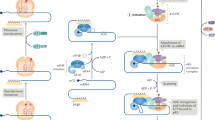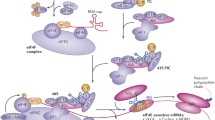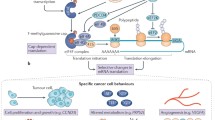Abstract
Cellular drug resistance is one of the principal obstacles to the clinical efficacy of cancer chemotherapy. In this review, we describe the potential role for translational regulation as a novel mechanism for modulating chemosensitivity. The evidence for the translational control of thymidylate synthase, dihydrofolate reductase, and p53 will be presented, as will experimental data showing how disruptions in this important regulatory process can lead to the rapid emergence of cellular drug resistance.
Similar content being viewed by others
References
Goldie JH,Coldman AJ: A mathematical model for relating the drug sensitivity of tumors to the spontaneous mutation rate. Cancer Treat Rep 63: 1727–1738, 1979
Bunz F,Hwang PM,Torrance C,Waldman T,Zhang Y,Dillehay L,Williams J,Lengauer C,Kinzler KW,Vogelstein B: Disruption of p53 in human cancer cells alters the responses to therapeutic agents. J Clin Invest 104: 263–269, 1999
Lowe SW,Ruley HE,Jacks T,Houseman DE: p53-dependent apoptosis modulates the cytotoxicity of anticancer agents. Cell 74: 957–967, 1993
Lowe SW,Bondis S,McClatchey A,Remington L: p53 status and the efficacy of cancer therapy in vivo. Science 266: 807–810, 1994
Hawkins DS,Demers GW,Galloway DA: Inactivation of p53 enhances sensitivity to multiple chemotherapeutic agents. Cancer Res 56: 892–898, 1996
O'Connor PM,Jackman J,Bae I,Myers TG,Fan S,Mutoh M,Scudiero DA,Monks A,Paull K,Sausville EA,Weinstein JN: Characterization of the p53 tumor suppressor pathway in cell lines of the National Cancer Institute drug screen and correlations with the growth-inhibitory potency of 123 anticancer agents. Cancer Res 57(4): 285–4300, 1997
Markowitz S: DNA repair defects inactivate tumor suppressor genes and induce hereditary and sporadic colon cancers. J Clin Oncol 18(Suppl 21): 75S–80S, 2000
Lynch HT,Lynch J: Lynch syndrome: genetics, natural history, genetic counseling, and prevention. J Clin Oncol 18(Suppl 21): 19S–21S, 2000
Fink D,Aebi S,Howell SB: The role of DNA mismatch repair in drug resistance. Clin Cancer Res 4: 1–6, 1998
Taverna P,Liu L,Hanson AJ,Monks A,Gerson SL: Characterization ofMLH1andMSH2DNAmismatch repair proteins in cell lines of the NCI anticancer drug screen. Cancer Chemo Pharmacol 46: 507–516, 2000
Lin X,Ramamurthi K,Mishima M: p53 modulates the effect of loss of DNA mismatch repair on the sensitivity of human colon cancer cells to the cytotoxic and mutagenic effects of cisplatin. Cancer Res 15: 1508–1516, 2001
Mathews MB,Sonenberg N,Hershey JWB: Origins and targets of translational control. In: Mathews MB,Sonenberg N,Hershey JWB (eds) Translational Control, Cold Spring Harbor Press, 1996, pp 1–27
Santi DV,Danenberg PV: Folates in pyrimidine nucleotide biosynthesis. In: Blakely RL,Benkovic SJ (eds) Folate and Pteridines, Wiley, New York, 1984, pp 345–398
Carreras C,Santi DV: The catalytic mechanism and structure of thymidylate synthase. Annu Rev Biochem 64: 721–762, 1995
Danenberg PV: Thymidylate synthase: a target enzyme in cancer chemotherapy. Biochem Biophys Acta 473: 73–79, 1977
Labow R,Maley GF,Maley F: The effect of methotrexate on enzyme induced following partial hepatectomy. Cancer Res 29: 366–372, 1969
Bonney RJ,Maley F: Effect of methotrexate on thymidylate synthetase in cultured parenchymal cells isolated from regenerating rat liver. Cancer Res 35: 1950–1956, 1975
Spears CP,Shahinian AH,Moran RG: In vivo kinetics of thymidylate synthase inhibition in 5-fluororuacil-sensitive and resistant murine colon adenocarcinoma. Cancer Res 42: 450–456, 1982
Washtein WL: Increased levels of thymidylate synthetase in cells exposed to 5-fluorouracil. Mol Pharmacol 25: 171–177, 1984
Swain SM,Lippman MC,Egan EF,Drake JC,Steinberg SM,Allegra CJ: 5-Fluorouracil and high-dose leucovorin in previously treated patients with metastatic breast cancer. J Clin Oncol 7: 890–899, 1989
Van der Wilt CL,Pinedo HM,Smit K,Peters GJ: Elevation of thymidylate synthase following 5-fluorouracil treatment is prevented by the addition of leucovorin in murin colon tumors. J Clin Oncol 12: 2035–2042, 1994
Keyomarsi K,Samet J,Molnar G,Pardee AB: The thymidylate synthase inhibitor, ICI D 1694, overcomes translational detainment of the enzyme. J Biol Chem 268: 15142–15149, 1993
Chu E,Zinn S,Boarman D,Allegra CJ: Interaction of gamma interferon and 5-fluorouracil in the H630 human colon carcinoma cell line. Cancer Res 50: 5834–5840, 1990
Chu E,Koeller DM,Johnston PG,Zinn S,Allegra CJ: Regulation of thymidylate synthase in human colon cancer cells treated with 5-fluorouracil and interferon-gamma. Mol Pharmacol 43: 527–533, 1993
Welsh SJ,Titley J,Brunton L,Valenti M,Monaghan P,Jackman AL,Aherne GW: Comparison of thymidylate synthase (TS) protein up-regulation after exposure to TS inhibitors in normal and tumor cell lines and tissues. Clin Cancer Res 6: 2538–2546, 2000
Carey J,Cameron V,de Haseth PL,Uhlenbeck OC: Sequence-specific interaction of R17 coat protein with its ribonucleic acid binding site. Biochemistry 22: 2601–2610, 1983
Bernardi A,Spahr P-F: Nucleotide sequence at the binding site for coat protein on RNA of bacteriophage R17. Proc Natl Acad Sci USA 69: 3033–3037, 1972
Winter RB,Morrissey L,Gauss P,Godl L,Hsu T,Karam J: Bacteriophage T4 regA protein binds to mRNAs and prevents translation initiation. Proc Natl Acad Sci USA 94: 7822–7826, 1987
Andrake M,Guild N,Hsu T,Gold L,Tuerk C,Karam J: DNA polymerase of bacteriophage T4 is an autogenous translational repressor. Proc Natl Acad Sci USA 85: 7942–7946, 1988
Gold L: Posttranscriptional regulatory mechanisms in Escherichia coli. Ann Rev Biochem 57: 199–233, 1988
Chu E,Takimoto CH,Voeller D,Grem JL,Allegra CJ: Specific binding of human dihydrofolate reductase protein to dihydrofolate reductase messenger RNA in vitro. Biochemistry 32: 4756–4760, 1993
Ercikan E,Banerjee D,Waltham M,Schnieders B,Scotto KW,Bertino JR: Translational regulation of the synthesis of dihydrofolate reductase. Adv Exp Med Biol 338: 537–540, 1993
Ercikan-Abali EA,Banerjee D,Waltham MC,Skacel N,Scotto KW,Bertino JR: Dihydrofolate reductase protein inhibits its own translation by binding to dihydrofolate reductase mRNA sequences within the coding region. Biochemistry 36: 12317–12322, 1997
Mosner JT,Mummenbrauer C,Bauer G,Sczakeil F,Grosse F,Deppert W: Negative feedback regulation of wildtype p53 synthesis. EMBO J 14: 4442–4449, 1995
Fu L,Minden D,Benchimol S: Translational regulation of human p53 expression. EMBO J 15: 4392–4401, 1996
Chu E,Koeller DM,Casey JL,Drake CC,Chabner BA,Elwood PC,Zinn S,Allegra CJ: Autoregulation of human thymidylate synthase messenger RNA translation by thymidylate synthase. Proc Natl Acad Sci USA 88: 8977–8981, 1991
Chu E,Voeller DM,Koeller DM,Drake JC,Takimoto CH,Maley F,Maley GF,Allegra CJ: Identification of an RNA binding site for human thymidylate synthase. Proc Natl Acad Sci USA 90: 517–521, 1993
Lin X,Parsels LA,Voller DM,Allegra CJ,Maley GF,Maley F,Chu E: Characterization of a cis-acting regulatory element in the protein coding region of thymidylate synthase mRNA. Nucleic Acids Res 28: 1381–1389, 2000
Chu E,Voeller DM,Morrison PF,Jones KL,Takechi T,Maley GF,Maley F,Allegra CJ: The effect of reducing reagents on binding of thymidylate synthase protein to thymidylate synthase messenger RNA. J Biol Chem 269: 20289–20293, 1994
Chu E,Allegra CJ: Antifolates. In: Chabner BA,Longo DL (eds) Cancer Chemotherapy and Biotherapy, 2nd edn, Lippincott-Raven, Philadelphia, 1996, pp 109–148
Bertino JR,Kamen BA,Romanini A: Folate antagonists. In: Holland JF,Bast RC,Morton DL,Frei E et al. (eds) Cancer Medicine, 4th edn, Williams and Wilkins, Philadelphia, 1997, pp 907–922
Schweitzer BI,Dicker AP,Bertino JR: Dihydrofolate reductase as a therapeutic target. The FASEB J 4: 2441–2452, 1990
Bertino JR,Silber R,Freeman M,Alenty A,Albrecht M,Gabrio BW,Huennekens FMJ: Studies on normal and leukemic leucocytes. IV. Tetrahydrofolate-dependent enzyme systems and dihydrofolate reductase. J Clin Invest 42: 1899–1907, 1963
Bertino JR,Cashmore E,Fink M: The ‘induction’ of leukocyte and erythrocyte and dihydrofolate reductase by methotrexate. II. Clinical and pharmacological studies. Pharmacol Ther 6: 763–770, 1965
Hillcoat BL,Swett V,Bertino JR: Increase of dihydrofolate reductase activity in cultured mammalian cells after exposure to methotrexate. Proc Natl Acad Sci USA 58: 1632–1637, 1967
Bastow K,Pabhu R,Cheng YC: The intracellular content of dihydrofolate reductase: possibilities for control and implications for chemotherapy. Adv Enzyme Regulation 22: 15–26, 1984
Domin BA,Grill SP,Bastow KF,Cheng YC: Effect of methotrexate on dihydrofolate reductase activity in methotrexate-resistant human KB cells. Mol Pharmacol 21: 478–482, 1992
Cowan KH,Goldsmith ME,Ricciardone MD,Levine R,Rubalcaba E,Jolivet J: Regulation of dihydrofolate reductase in human breast cancer cells and in mutant hamster cells transfected with a human dihydrofolate reductase minigene. Mol Pharmacol 30: 69–76, 1986
Grem JL,Voeller DM,Geoffroy F,Horak E,Johnston PG,Allegra CJ: Determinants of trimetrexate lethality in human colon cancer cells. Br J Cancer 70: 1075–1084, 1994
Gollerkeri A,Chu E: Translational regulation of DHFR expression in human colon cancer RKO cells. Proc Am Assoc Cancer Res 42, 783: 4205a, 2001
Ercikan-Abali EA,Banerjee D,Skacel N,Scotto KW,Bertino JR: Cis-regulatory elements at the 5′UTR regulates the expression of dihydrfolate reductase (DHFR) at the translational level. Proc Am Assoc Cancer Res 39, 432: 2946a, 1998
Greenblatt MS,Bennett WP,Holstein M,Harris CC: Mutations in the p53 tumor suppressor gene: clues to cancer etiology and molecular pathogenesis. Cancer Res 54: 4855–4878, 1994
Harris CC,Hollstein M: Clinical implications of the p53 tumor-suppressor gene. NEngl J Med 329: 1318–1327, 1993
Levine AJ: p53, the cellular gatekeeper for growth and division. Cell 88: 323–331, 1997
Ko LJ,Prives C: p53: puzzle and paradigm. Genes Dev 10: 1054–1072, 1996
Vogelstein B,Kinzler KW: p53 function and dysfunction. Cell 70: 523–526, 1992
El-Deiry W,Tokino T,Velculescu VE,Levy DB, et al.: WAF1, a potential mediator of p53 tumor suppression. Cell 75: 817–825, 1993
Bunz F,Dutriaux A,Lengauer C: Requirement for p53 and p21 to sustain G2 arrest after DNA damage. Science 282: 1497–1501, 1998
Maltzman W,Czyzyk L: UV irradiation stimulates levels of p53 cellular tumor antigen in nontransformed mouse cells. Mol Cell Biol 4: 1689–1694, 1984
Shieh SY,Ikeda M,Taya Y,Prives C: DNA damage-induced phosphorylation of p53 alleviates inhibition by MDM2. Cell 91: 325–334, 1997
Gu W,Roeder RG: Activation of p53 sequence-specific DNA binding by acetylation of the p53 C-terminal domain. Cell 90: 595–606, 1997
Liu L,Scolnick DM,Trievel RC,Zhang HB,Marmorstein R,Halazonetis TD,Berger SL: p53 sites acetylated in vitro by PCAF and p300 are acetylated in vivo in response to DNA damage. Mol Cell Biol 19: 1202–1209, 1999
Sakaguchi K,Herrera JE,Saito W: DNA damage activates p53 through a phosphorylation-acetylation cascade. Genes Dev 12: 2831–2841, 1998
Kastan MB,Onyekwere O,Sidransky D,Vogelstein B,Craig RW: Participation of p53 protein in the cellular response to DNA damage. Cancer Res 51: 6304–6311, 1991
Zhan QF,Carrier F,Fornace AJ: Induction of cellular p53 activity by DNA-damaging agents and growth arrest. Mol Cell Biol 13: 4242–4250, 1993
Fu L,Benchimol S: Participation of the human p53 3_UTR in translational repression and activation following gammairradiation. EMBO J 16: 4117–4125, 1997
Chu E,Copur SM,Ju J: Thymidylate synthase protein and p53 mRNA form an in vivo ribonucleoprotein complex. Mol Cell Biol 19: 1582–1594, 1999
Ju J,Pedersen-Lane J,Maley F,Chu E: Regulation of p53 expression by thymidylate synthase. Proc Natl Acad Sci USA 96: 3769–3774, 1999
Ju J,Chu E: Translational regulation of 5-FU induced p53 expression in human cancer RKO cells. Proc Am Assoc Cancer Res 41, 854: 5422a, 2000
Author information
Authors and Affiliations
Rights and permissions
About this article
Cite this article
Schmitz, J.C., Liu, J., Lin, X. et al. Translational Regulation as a Novel Mechanism for the Development of Cellular Drug Resistance. Cancer Metastasis Rev 20, 33–41 (2001). https://doi.org/10.1023/A:1013100306315
Issue Date:
DOI: https://doi.org/10.1023/A:1013100306315




